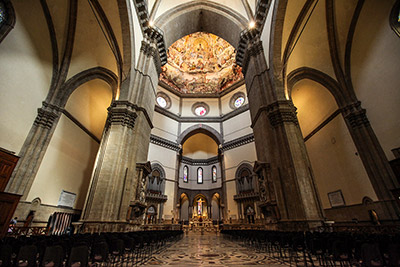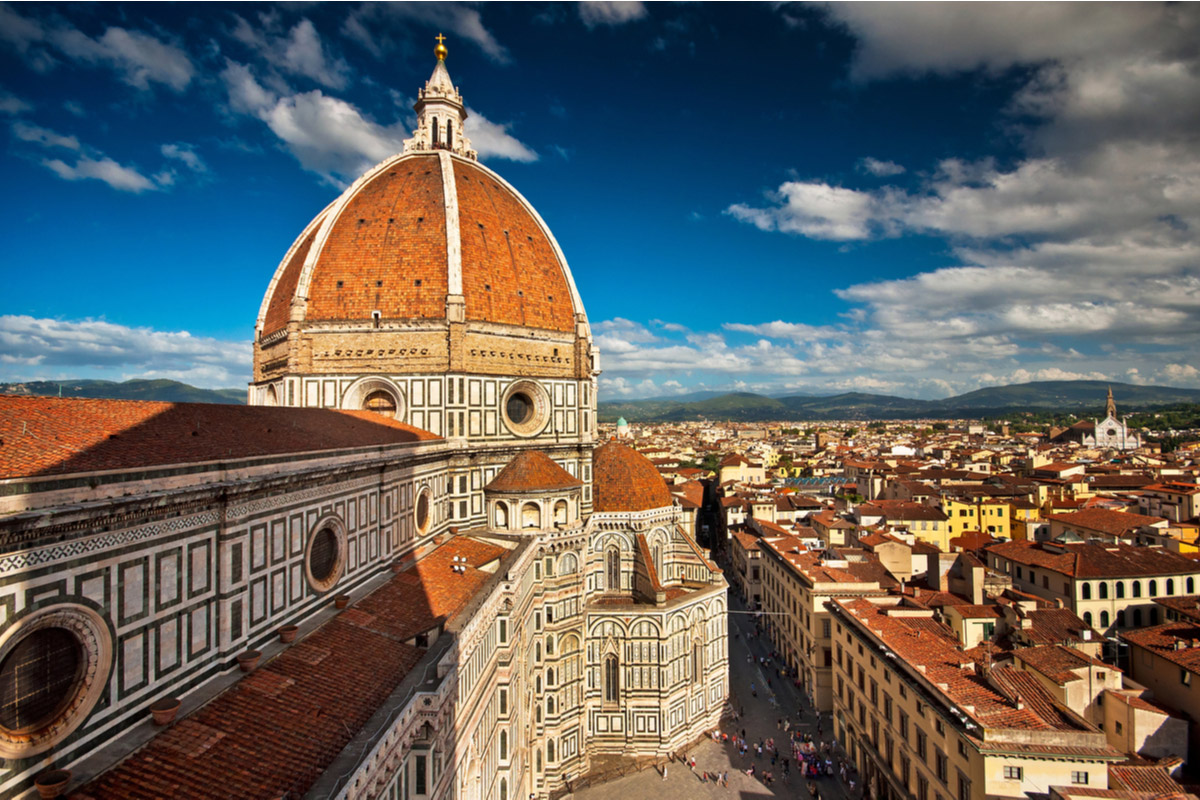Florence Cathedral

One of the most significant structures in the world, or at least in Florence, the Florence Cathedral innovatively combines architectural innovation with jaw-dropping religious frescos. Begun in 1296, and completed just over 100 years later (sans dome - but more on that later), the Florence Cathedral has a fascinating history begging to be explored.
Things to See & Do at Florence Cathedral
1. The Dome

A The iconic terracotta dome that sits atop the Florence Cathedral was built from 1420 to 1436, after Florence decided it’s open church should no longer sit open. A revolutionary feat of engineering for its time, architect Filippo Brunelleschi developed a double shelled dome concept that still stands as the largest brick dome ever built to this day. Visitors can climb the 463 steps to the top of the dome, spiralling up in the gap between the two domes.
2. Giotto Bell Tower

Between the 19th-century facade and the Baptistry, you will find the Giotto bell tower. Despite being named after the famous 14th-century painter, Giotto may have not had much input into the build at all, dying three years into the project. Instead, the bell tower was developed by Nicola Pisano, and completed later by Francesco Talenti, who was named head architect. As you look up at the bell tower, you can notice the subtle differences between the sections made by the two different architects.
3. The Baptistry

Located just in front of the Cathedral, within the Piazza del Duomo, the Baptistry is one of the most important monuments in all of Florence. Though to have been built over the ruins of a Roman temple, which was later consecrated as the Baptistry of Florence, this is the oldest religious site in the city. Dedicated to the city’s patron saint, this octagonal building features white and green marble in geometric patterns, as well as fascinating statues and intricately crafted doors.
Admission into the Baptistry is 10€, and you should leave around 30 minutes to fully appreciate the building’s beauty.
4. The Crypt

Part of the Duomo complex, and managed by the Museum, the Crypt of Santa Reparata is the joint oldest evidence of a place of worship for Christians in Florence, thought to have been built at the same time as the Baptistry. The Crypt houses the remains of the original church on this site, as well as other Early Christion and Roman artifacts, such as marble carvings, ceramics, metal implements, and glass.
If you go ahead and purchase the combined ticket for the Cathedral, which costs 18€, you will not need to pay any extra to visit the Crypt.
5. The Main Cathedral

The Cattedrale di Santa Maria del Fiore, or Il Duomo, is an absolute must-see when you are in Florence. Designed in a very Tuscan-Florentine style, take a walk around the entire facade to marvel at the green and white marble facade. Inside the Cathedral, be sure to check out the frescos and 14th century stained glass windows. A visit to the main Cathedral can last up to an hour.
The main Cathedral is free to enter, however you might like to consider a guided tour. Prices for a guided tour of the Cathedral can range from anything around 20€ to 50€ depending on whether you opt for a private or group tour.
6. The Museum

The Cathedral Museum houses many works from the cathedral and the Baptistry that were removed for preservation. The Museum therefore is a fantastic place to visit if you want to find out more about the Cathedral’s changes over the centuries. The majority of the sculptures preserved in the museum are those which were originally chosen for the facade, before it was replaced with something more modern. You can also see 14th century works from the Bell Tower, tools and materials used to build the Cathedral, and sculptures by Nanni di Banco, Donatello, and Michelangelo.
Admission into the Museum is 10€.
7. The Giorgio Vasari's Last Judgement

Vasari’s The Last Judgement is located on the interior side of the huge dome within the Florence Cathedral. You can see this fresco along your tour of the Cathedral itself. The best view of the painting is from a viewing ledget located about two thirds of the way up the climb to the top of the dome.
The Last Judgement was painted by Giorgio Vasari from 1572 to 1579, commissioned by Cosimo I 120 years after the dome’s architect Brunelleschi’s death. Though Bruneslleschi requested that his dome be covered in gold mosaics the Florence Cathedral opted instead for an enormous fresco. In fact, this fresco is so big that it is the largest one in the world, covering about 43000 square feet.
Vasari was inspired by Michelangelo’s The Last Judgement which covers the ceiling of the Sistine Chapel. As you gaze upon Vasari’s work, the inspiration is obvious. Against the backdrop of heaven itself, the floating figures are reminiscent of Michelangelo’s remarkable design. Despite Vasari’s death in 1574, The Last Judgement was finished by Federico Zuccaro. In 1996, the Florence Cathedral undertook a huge project to clean and restore the fresco in all its glory.
































